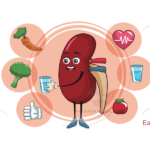Understanding the kinetics of how a drug is removed from the body is foundational for creating and adjusting rational dosage plans tailored to individual patient needs. Three key pharmacokinetic parameters must be comprehended: bioavailability (F), volume of distribution (Vd), and clearance (CL). The first two have been previously discussed.
Drug Elimination
Drug elimination comprises both the metabolic deactivation and the excretion of the drug. The drug is removed exclusively from the central compartment, namely the bloodstream, which is in balance with peripheral compartments, including the drug’s site of action. Depending on the body’s efficiency in eliminating a drug, a specific segment of the central compartment can be considered fully ‘cleared’ of that drug within a designated time frame.
Clearance (CL)
Clearance is the theoretical volume of plasma from which a drug is entirely removed in a specific time unit, similar to creatinine clearance. It is calculated using the formula:
CL = \frac{Rate of Elimination}{C}Where (C) is the plasma concentration.
First Order Kinetics
For the majority of drugs, elimination processes are not saturated at clinically relevant concentrations. These drugs follow First-order kinetics, where the rate of elimination is directly proportional to the drug’s concentration. In simpler terms, a constant percentage of the drug is removed from the body within a unit of time.
Zero Order Kinetics
Some drugs follow Zero-order kinetics, where the rate of elimination remains constant, irrespective of the drug’s concentration. Examples include substances like ethyl alcohol. This is also known as capacity-limited or Michaelis-Menten elimination.
Nonlinear Elimination
Certain drugs, such as phenytoin and theophylline, transition from first-order to zero-order kinetics as the dosage increases. This leads to a disproportionate increase in plasma concentration, which is termed as ‘nonlinear elimination’.
Blood Flow Dependent Elimination
For a few drugs, the organ responsible for elimination (e.g., liver, kidney) has a capacity that far exceeds the amount of drug presented to it, making the drug’s elimination dependent on blood flow.
Plasma Half-Life
The Plasma half-life (t1/2) is the time required for the plasma concentration of a drug to reduce by half. It can be calculated using the formula:
t_{1/2} = \frac{0.693 \times V}{CL}
Half-life is not an exact measure of drug elimination but serves as a useful guideline. For instance, nearly complete drug elimination occurs within 4-5 half-lives.
First Order vs Zero Order Kinetics in Half-Life
For drugs following First-order kinetics, the half-life remains constant as both (V) and (CL) are stable. In contrast, for drugs following Zero-order kinetics, the half-life extends as the dose increases, making the concept of half-life less meaningful for these drugs.
Certainly, I can continue the content in a similar style as the previous section. Here it is:
Repeated Drug Administration
When a drug is administered at short intervals, it accumulates in the body until the rate of elimination equals the rate of intake, achieving a steady-state plasma concentration (Cpss). The formula to calculate this is:
Cp_{ss} = \frac{Dose Rate}{CL}
Doubling the dose rate would consequently double the average (Cpss). If the therapeutic plasma concentration and the clearance rate (CL) are known, the required dose rate can be calculated as:
Dose Rate = Target Cp_{ss} \times CLDose Rate-Cpss Relationship
The relationship between dose rate and (Cpss) is linear for drugs eliminated by first-order kinetics. However, for drugs like phenytoin that follow Michaelis-Menten kinetics, the elimination switches from first-order to zero-order kinetics within the therapeutic range. The formula for their rate of drug elimination is:
Rate of Drug Elimination = \frac{(V \times C){max}}{K_m + C}Where (C) is the plasma concentration, (Vmax) is the maximum rate of drug elimination, and (Km) is the concentration at which the rate of elimination is half-maximal.
Plateau Principle
When a drug is administered repeatedly before 4 half-lives (t1/2) have passed, the plasma concentration plateaus and fluctuates around a steady-state level. This is known as the plateau principle. The amplitude of these fluctuations depends on the dose interval relative to the (t1/2). Generally, smaller doses administered more frequently result in less fluctuation, balancing efficacy and side effects.
Target Level Strategy
For drugs like anticonvulsants and antidepressants, where effects are not easily quantifiable and the safety margin is narrow, it’s best to aim for a specific plasma concentration within the therapeutic range. Drugs with short (t1/2) achieve target levels only intermittently, but this is often therapeutically acceptable.
Loading Dose
An initial loading dose is often administered to achieve the target concentration rapidly. It is calculated as:
Loading Dose = \frac{Target Cp \times V}{F}
This dose is followed by maintenance doses to sustain the target (Cpss).
Monitoring of Plasma Concentration
Monitoring is particularly useful for drugs with a narrow safety margin or large individual variations. The revised dose rate can be calculated as:
Revised Dose Rate = \frac{Previous Dose Rate \times Target Cp_{ss}}{Measured Cp_{ss}}Healthcare professionals can more effectively devise and adjust individualized treatment plans for each patient by understanding these various aspects of drug kinetics and administration strategies.
📚 AI Pharma Quiz Generator
🎉 Quiz Results
Medical Disclaimer
The medical information on this post is for general educational purposes only and is provided by Pharmacology Mentor. While we strive to keep content current and accurate, Pharmacology Mentor makes no representations or warranties, express or implied, regarding the completeness, accuracy, reliability, suitability, or availability of the post, the website, or any information, products, services, or related graphics for any purpose. This content is not a substitute for professional medical advice, diagnosis, or treatment; always seek the advice of your physician or other qualified health provider with any questions you may have regarding a medical condition and never disregard or delay seeking professional advice because of something you have read here. Reliance on any information provided is solely at your own risk.









